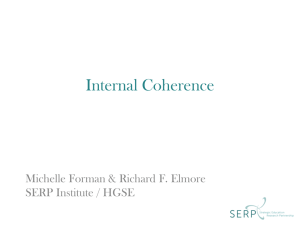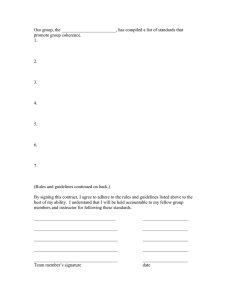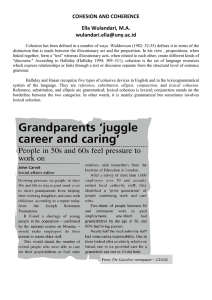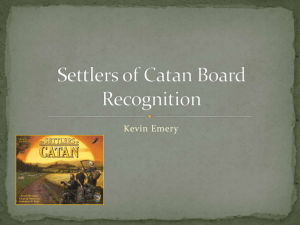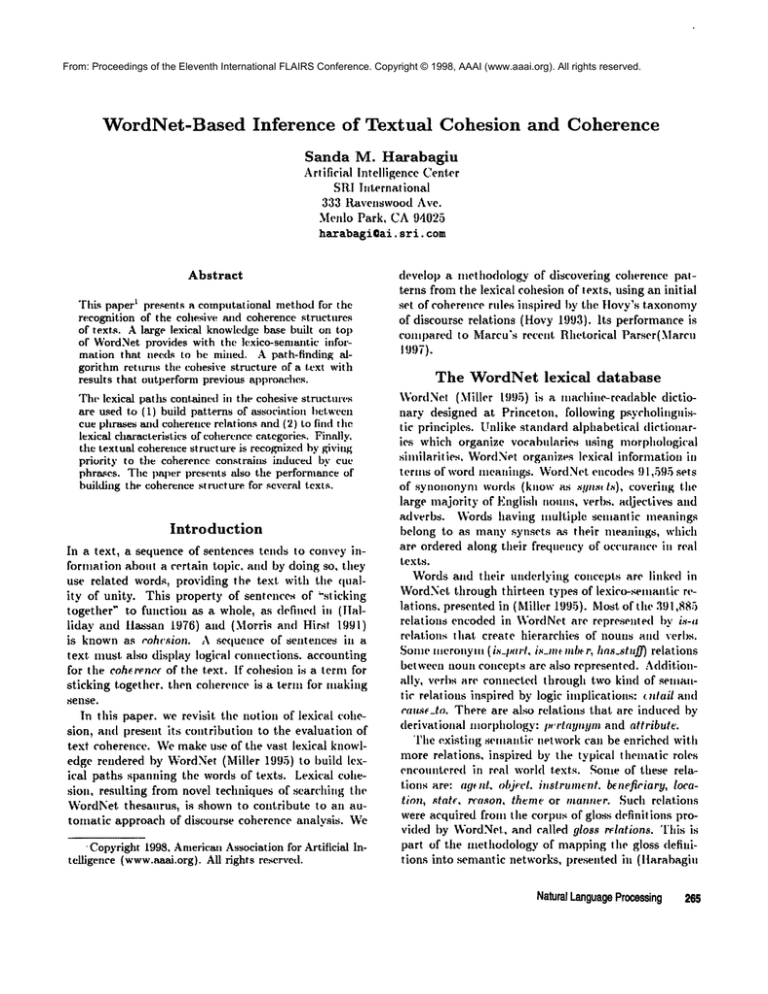
From: Proceedings of the Eleventh International FLAIRS Conference. Copyright © 1998, AAAI (www.aaai.org). All rights reserved.
WordNet-Based Inference
of Textual
Cohesion and Coherence
Sanda M. Harabagiu
ArtificiM Intelligence Center
SRI lnternat tonal
333 Ravcnswood Ave.
Menlo Park. CA 94025
harabagi@ai,
sri.tom
Abstract
"rhis paperI presents a computational methodfor the
recognition of the cohesive and coherence structures
of texts. A large lexieal knowledgebase built oil top
of WordNetprovides with the lexico-senmntic information that needs to be mined. A path-finding algorittam returns tim cot~esive structure of a text with
results that outperformprevious api~roaches.
The Icxical paths contained in the cohesive structures
are used to (1) build patterns of association between
cue phrases and coherencerelations and (2) to find the
lexieal dim’acterist.ics of coherencecategories. Finally.
the textual coherencestructure is recognizedby giving
priority to t.lne coherence constrains induced by cue
phrases. "[’he paper presents also the performanceof
building the coherencestructure for several texts.
Introduction
In a text, a sequence of sentences tcnds to convcy information about a certain topic, and by doing so, tlney
use related words, providing the text. with the quality of unity. This property of sentences of "sticking
together ~ to fnnction as a whole, as defined in (Ilalliday and llassan I976) and (Morris and Hirst 1991)
is known as cohesion. :% sequence of sentences in a
text. must also display logical connections, accounting
for the coh~lvnce of the text. If cohesion is a term for
sticking together, then coherence is a term for making
sense.
In this paper, we revisit the notion of lexicaL cohesion, and present its contribution to the evaluation of
text coherence. Wemake use of the vast lexical knowledge rendered by WordNet(Miller 1995) to build [cxical paths spanning the words of texts. Lexical cohesion, resulting from novel techniques of searchivg the
WordNetthesaurus, is shown to contribute to an automatic approach of discourse coherence analysis. We
¯ Copyright1998, Amerk’anAssociationfor Artificial Intelligence (www.aaai.org).All rights reserved.
develop a methodology of discovering coherence proterns from the lexical cohesion of texts, using an initial
set of coherencerules insi)ired Iff the tlovy’s taxonomy
of discourse relations (Hovy 1993). Its performance
compared to Marcu’s recent Rhetorical Parser(Marcu
t997).
The WordNet
lexical
database
WordNet(Miller 1995) is a nmchilne-readable dictionary designed at Princeton, following psycholinguistic principles. Unlike standard alpimbetical dictiouaries which organize vocabularies using morl)hological
similarities. WordNetorganizes lexical information in
ternts of word meanings. WordNetencodes !l 1,595 sets
of synoxuonynlwortls (knowas .sllns~/.s), covering tim
large majority of Englisln nouns, verbs, adjectives and
adverbs. Words having multiple semantic meanings
belong to as many synsets a.s their meanings, which
are ordered along their frequency of occurance in real
texts.
Words and their underlying concepts are linked in
WordNetthrough thirteen types of lexico-semanl.ic relations, presented in (Miller 1995). Most of the 391,885
relations encoded in WordNctare represented by is-a
relations that create hierarchies of nouns and verbs.
Somemerony,n(i.s_tmrl, is_m~, robe r, has_stuf~ relations
between noun concepts are also represented. Additionally, verbs are connected through two kind of senmntic relations inspired by logic implications: (. ulail and
cause_to. There are also relations that are induced by
derivational nmrphology: I,.rlayuym and attribute.
The existing semantic network can be enriched with
more relations, inspired by the typical thematic roles
encountered in real world texts..qonte of these relations are: ag~nl, obfl’cL inslrument, beneficiary, location, state, rrason, theme or mauner. Such relations
were acquired from the cort)us of gloss definitions protided by WordNel.,and called gloss relations. "l’lfis is
part of the methodology of mapping the gloss definitions into semantic networks, presented in (llarabagiu
NaturalLanguage
Processing
265
A path-finding
that svnt.ell(’e.
Tile resuh of this step is a wel) of concel)tS conne(’ted through relations that werl. Imil(ling
the I)at]]~ dete(’ted at step I.
algorithm
A path-fitMiug atgorhhut w+L~dt’sigtled to find seutatlt.i¢
paths between the woMsofa text. It eOltSisl.s of four
steps, that Sllt’¢essively
perrortll
sear(’hes
ill WordNel.
and consolidat.e the et)hesion strllt’tllreS.
"[’lip
search
nlechauism uses three types of primitives
that con.,+truel +t SPIILaIL|,[C path l)et¢,’een a pair of concepts l)v
using a different set of knowh.dgeIm,se relations. "l.’]lose
prinlitives
est.al>lish
beLween a pair of WordNet euneepts (C’t. C.z) : (i) .~imld, eom,’ctions when th<.re is a
¢oneel)t. (":4 sut’il tllat Ihere is a Setluence of WoMNet
relations v+ from Ct t.o (’-’3 and another one from (’2
("}:(if) :.tlo+s (’O+lttt:t’liot].~ if there is a se(lliel]ce orgl(Jss
relations Pqtroll (’1 Io a gloss con(.’epl.. (J:l al]d anotiler
one fro]]] (72 to (’.3: anti (iii) combined con,+etions if
there is a WordNetor a gloss concept (-.’:1 such that it
is cotmected to (’t and (’2 by sequences of WordNet
or gloss relations.
These primitives are ,sed ow.r and
over in all the four steps of the pat h-ill,cling algorithm:
Step 1: Find paths that explain textual relations
For a given iexieal relation e that links co,<’tpli Io
yore’eel.i.f.ht"
search slrategy is to look fur tlw same
h, xit’al relatiot] v ill the glosses of m,arlLv conct.pt.s.
We have investigated
three nwthods that have dilferent seart’h strategies.
The first method searches for
relat.iou I" lirst il] tile gloss of (’onVtl#i and then iu t.h~’
glosses ()f ¢oneel)tS t hat (’onl]e¢t h co,c + pl; via siln iJle/gh)ss/conll)ine(l I)aths. %%’hen
relation r is follll<l
ill
Sl]ch ~’t
glOSS. (’Orllle(’tiOtlS
are s()llghr
bct.weP]l
desti]latiott (’ot](.’ept of that rvl,+tt[o]t and (’(’mc<pl.,..
Tilt’ se¢oll(I iIlelho(l is usedwile], r is a(lja(’t.nt
the texI Io a relation rl. This metho(I searehvs fkJl"
relation r il, l,lte glosses of conceptslinked via a sit/]i)]e/gloss/(’olnl)il]e ¢OI]lle(’tit)ll Io tile a(Itlress (’ou(’elJt
or 1.1. Whenrelation r is round ill such a gloss, (’onl+leet[olls are sollghtbet weel]t hedt.Stillat iOll et)]l(.’el)t
that relal.iOl] attd t’<mr+pl.,.
Finally, the thh’d rttetho(I, svar(’llv+ lirst for all
glosses that contain (’om’rpti and tttarks tile concepts
ill these glosses+us~][o.s.s_vollet])ti. ’[’hen. l.he melho(I
searches for relation r ht tile gloss of st)tilt,
¢onecl)t
that conne(’ts to ally of the ,ll..+s_co.e(l)t;i(lentified t)vfore. ’kVhet] relation r is round, si]nt)le/ghJss/cond)ine(I
connet’tions are sought. I)etween ils (lest|nation (’on(’el)t.
and con(’t plj.
Step2: Determine the local
context
of a sentence
Therole of this step is to merge the paths found in
Step I /’or all le×ical relations of a sentence into a graph
where(’t)]]llHOl] col]cel)l.s are riot rel)t,ated. This consolit|ate(:[ graph is eo]]sitiered to represent the (’tJ]llex! 0|"
266 Harabagiu
Step3: Find cohesion paths between sentences
This ste[) takes atlvantage or the (’t, lh,ctive nwaning
all st.]ltent’es in the i~exl I)y lin(ling conue(’t ions I)el wt,el]
the hJcal t’OlllvXls, x,V<’ have’ (levelolwd three tliffvrent
ways (Jr retrieving ¢onnec’i.it+ns betweentit(’ ¢on(’el)tS
of different sellterlces.
(,)lit" wayis to lin(I knowle(Ig+’
I’Jase pal.its
between the r¢ I’b.~
or ()lit,
Selltelt(’e
and tile
I:t vimor the or.herSelll4.’lL(’e.
%V(y
select only ’+’el’l)s sin(’e
tilt’)’
inthwe t.he dominant knowledge (Jr a St’lltence:
knt)wh’dge
al)out a(’liollS,
slates or i,V<.lltS.
"l’]]l.
s(’eo]ld
nmtho(lfin(is pathsI)olWeell flit’ vi,rl)s t)f otle Selllell(’e
all(I i.he ]lodes of the hwal <’Olltext of tilt, Otlli’r sel]l.ellqe. A third wayis to l)air tilt’ nodesfrom tile Io(’ai
¢Olltexts of onese]ll.en(’e with tilt:’ nodesfrom tile Io(’al
(.’()]]text of the other setltett(’e. For ea(’h senten(’e,
conne(’tions Io all previously I)ro(’essvd senten(’es
srar(’he(].
Step4: Consolidate the cohesion structure of a text
The glol)al cohesion structure of a se(llltntce
or SCltletlces is achieved by vliminating t.he repeating con(’epts throughout textual paths and local contexts.
lilt’
]:irsl,
eO]llltmOlt
(’OllCel)ts
I)PIwt,ell
tilt’
lext.iJal
(’ott-
IL(’(’li(.)ll,’,
a.rP redu¢e(IIJy al)l)ly]ng the samei)rocv(lure
;L.; the oneusedin ,b’te I) 2 for I)ltil<.ling the h)¢aleutllexts.
"l’l,eu. thL-. llew sl.rll(’l itr(, is tuat(’ite(I againsteachlocal
(’oll|l’xt.
alltl
COllllliOll
(’Oll(’el)tS
al’P fllrlhl,r
redllt’V(I.
Lexical paths as forms of cohesion
Thefirst algorithln l.hat sPar(’ILed for h..xi(’al (’oh(’si(,n
re]af.iOllS
it1 t~.xls was (h,vise(I t)y Morris ,:lilt[
Ilirst..
Their al)l)roa(’l, found well ow,r !)1)~7( of t, int uitive
h,xical relatiol,s from a st’f of five ,’xan,I)h.s I~res,’nte(l
ill (Morris 15)88). all(l w+,s al)]e to rctrieve It OILt of
lhe 16 nonsystel]lati("
h.xical chains given as cxanll)les
in (l[alliday a,ld Ilassan l.q7fi) (thus an 87(+ff recall).
These l)romisi ng results l)rom[)ted t lw considerat ion
Ilshlg XVol’(lNet for the detect|oiL of h’xical (’ohesioll rclalions from the large c’orl)uls provicle(I I)y "l’t’vvl)auk
(Marcus et a1.19.()3). In the pro(’ess, we (lis(’overe(I
teresting ;-tsso(’iati(ms wil the approa(’h of Morris au(
tlirst.,
as well amcomplex(liverg,,twes.
The algorithm devised I) 3’ Morris and Hirst fo build
h.xical chains uses live types of thesaural relations that
can I)e generalized Io l.h,’ simple, gloss or colnbil,e(l
(’onne(’tions used Iw the l)a.th-findil]g
algorithln.
(’ontrasl.
the i)ath-findillg
algorithm provi(h.s with
wea]l.h of [exical (’o]lesion relalions, lnOSl, of them un¢overe(I l)y the algorithnl
of Morris and Hirst. I"or
example. Fur the text presented in (Morris and llirst
I~J.ql), wc found 38 h,xical paths as opposed t.o 1.heir
lexical chains. Our resuhs, flllly detailed ill (llarabagiu
1997) showall increase in tile recall with 44%.Tile precision is enforced as well, since the paths have to comply with the constraints of the local contexts. Even for
tile paths that correspond to their lexical chains, the
inter-relationships between the words were more dense.
Cue Phrases as Coherence Indicators
Discourse cue phrases are words and phrases that signal information regarding the logical flow of the di.~course, e.g. the coherence relations among discourse
Fragments. However, tile majority of the cue phrases
are ambiguous, in the sense that they have also alternative meanings, where the word doesn’t contribute to
the discourse level semantics, but rather to the semantic meaning of the sentences.
Building on the previous work encompassing the
studies presented in (Hirshberg and Litman 1993),
(Siegel and McKeown
1994). ((;rosz and Sidner 1996),
the approach used in (Marcu 1997). extends the problem of cue phrase disamlfiguation by distinguishing the
discourse sense of a cue phrase into finer meanings, col
responding to the rhetorical relations it, indicates. Our
approach has many similarities
with Marcu’s method
because we focus on the recognition of a ha.sic set of relation.., derived Fromthe top of the taxonomyobtained
by Hovyin (llovy 1!19::~).
The cardinality of the set of potential discourse
markers we considered is far Sttlaller than the one used
by Marcu. We have been considering only 29 cue
phrases, a.s opposed to Marcu’s study of 4511 discourse
markers. The difference in ~ize may be motivated by
tilt’ Fact thai we aimedat complexh.xico-semant ic processing of each example, and thus required more effort
per cue phrase.
Since our fbcus is on the correspondence between
cue phra.ses, senlantic paths and coherence relations, we gathered all the paths tagged with the
same cue phrase and the same coherence relation in
classes cu~-Ph’a’~
C
Next each path front every
"t’oh~’l’t rlt’l --rt’l,’ltiorl"
cuc-phrast
Ct’ohert.tlt’~--relatloP~
is transformed into a pattern by applying the t’ollowing m,ecession of operatious:
o 1. Every synset is replaced with its part-oF-speech
tag. Therefore, every concept is represented only by
its syntactic category.
o 2. Successions of the same relation in a path are
substituted by an instance of that relation, connecting
the first and the last argumentof the chain.
o 3. Every succession of gloss relation.s is replaced by
a single relation, conneetitlg the first gloss concel>t to
the last gloss coucept frorn l)ath. This new relation is
associated with a list, containing all the labels of the
relations it subsl.itutes in Ihe original l)ath.
o 4. Pattern extraction is performed, by identifying
tile longest subpath that is commonto most of the
membersof the class. Patterns are formed as regular
expressions (of part-of-speech tags and directed relation labels) in which the commonsubpath is identical,
whereas the disjoint parts gather all the substitutable
relations that can be found in the various transformed
paths of that (:lass.
The evaluation of the cue-phrase disambiguation approach was performed on two different sets of texts,
pertaining to different genres: a collection of Wall
Street Journal articles, using 1403 words, and a 1528
word long fragment from the scientific abstracts provided by the U.S. Department of Energy, both available from the ’lYeebank project. Three independent
judges identified the meanings of the cue phrases and
validated the resuhs of tile disambiguation procedure.
The results show that 86.45~. of the discourse senses
of the cue phrmses were discovered with a precision of
72.91t~, a result which is close I.o what Marcuobtained
(Marcu 1997) with a surface-based algorithm.
Text Coherence
It is well established that the structure of a text conI.ains more than the collect.ion of tile sentence structurps: its meaning is determined l’>y the logical relations between sentences. This additional meaning is
provided by the int’erences establishing tile interpretation of the text under the assumption that it is coherent. C.oherence inference relies on pragmatic know[edge, using various aspects of commonsensereasoning
ruechanisnm. ]lere, we describe the effect of knowledge gathered front a large linguistic database on the
recognition of coherence relations and on the general
structure of tile discourse.
Weconsider a taxonon,y of coherence relations,
initially ret>orte(l in (Mater anti Hovy 1992) that
is (napped into the cohere,we categories devised in
(Kcitler 1995). These coherence categories are characterized by properties that can be recognized from the
information brought forward by the lexico-semantic
I)aths. Lists of cohesive constraints, ms indicated by
I>rOl)erties of the sequences derived from the WordNet
paths, are derived and hell> recognize each coherence
relation.
The defining constraints of the coherence relations
also determine tile text spans underlying the coherence structure of a text. Resemblanceor Cause-Effect
relations can be recognized between pairs of textual
units (clauses or sentences), whereas Contiguity relations organize the other binary relations into segments
of coherence structures. Wefavor this organization
of the textual coherence structure to the hierarchiNaturalLanguage
Processing
267
Contixuity
Relation
Resemblance
Relation
Resemblnnce
Rela~on
F_.n.
....
[ ...2 ......
I
Rexemblaner
Relation
Cause-Effect
Relation
F.--r .... ;
. __
;1 .r.__
L ........................................
!
(’onti#uiO"
Relation
~i
Resemblance
Relation
,~ +,
~~
I
i
[ ............
"
Rexemblance
Relation
[--"’’-q
Cause-Effect
Relation
....... ft.
I
J
Resemblance
Relatian
i,.-I
- - -
~ .~
+,-
t "ontigrtity
i
o~
Ii
I
L
’ Resemblnnee
Relation
r---- ;
Re~embltmce
Rehgion
Resemblance
Rel¢lion
CotL~e-lfffect
Relation
I
- --
..r,.__
l"ignre ! : ( ’oherence
st l’llC| III’P based
unsenl;lllt it’ pat 11.,4
cal organization.
"fhe only other autolnath" nwlho<l
of building tile rhetorical tree eta tcxt we art’ awal’c o["
is the method inlph,nlt,nted
ill (Marcu 1996). Marcu
r,,tklrnnllates
the definition of the struclure tit a t,,xt.
as devised by tile RS’f (Mann alLd "fhollll>S<m 19t4S)
relations, tie eonsidel’s a fornlal treatnlenl of the cohel’elLt’e st rllC’t lll’t" hy l’i.ly]ng Oli ,~1 .~h;t[tow discuttrse analyzt, r bascd till cue phrase inforrnatitm.
Tilt’ inslJ,’ction of tilt, eullt.re,w,, and culmsiott constraints ilill>OSed by (.he struclnri + of senmtitic l>aths
triggers tile discoveryof IPt.,itmbllillct +lll([ (’tilts< -Eft< r/
relal.ions. "File (’ontiguilfl relaliuns are (hqerntit,ed by
conslraints t hat involve tb’st mblant’, or (’lUst-Eft<,’/
rt.lal.iOllS, i>roducinga higher lev,,l of the texl cult,,rt,lW,’
sl.rnet life. [:igtn’e I ilium rates a possit)h, lexl coherenct’
t’;|.l’ll(’t Ii rip.
The feet that. eoher,’ncc conslraints use infilrnlation
rendered by the cohesioit l>aths pernlits tilt, dl,tt,cliulJ
Of eollel’ence
eVell whPll (’lit,
phrases are not ]irPSellt
ill it, text passage is the illitiZl
departltre wc lake |’rtJln
Mareu’.s approach. The eoht.rence strltctnrt,
eta text
is produced by the steps of lhe algorit.hnl:
..llgorithm build_cohet~nrt+4ructurc( tex’t
I. B,ild the st mantw
p, fh.~ .~pa,nin.qtl," leJ’l:
2. lt~roqni.:¢ dis,’our.~t cmpbr,is* s ,,d tht ir
cvrrt SlJondin.qcotv rt net t~ latiou:
3. Find rest ruble,c+" mid cau.~r-+fftct rrlati,, b, In’re,
te.rt tulits t’orirlet’lt
d b!] tiler(,
than~ semanticpaths.
.~. iS (the cut phrnsrirtdirnte.~ atit,tht r ,’oh( rtnce r¢ hi(it,n)
then .+eh’et Ibat rrlalion:
5. l"ind eontiyuily relations spanning text pa.+sn.q+s
cocored by a dt nse webs oS semanlic pnths:
6. Output the coherence structur+ :
(coherence rclal.ion; text passage: semantic paths);
Harabagiu
Discussion
and evaluation
The perfornlanct, evahlatiun of l.h,, algol’ithnl for lindhlg lilt" (’Oh(’l’i’ll(’(’ mtrll(’lllrP tif;i It,x|. was doll(" I),%
sider(rig Illtlrt’ lhall It) l,,xls frtml tlw Wall .qlrt, I .him’n,I eorlut.+, availabh, in the "rr,+,’l’,ank liro.i<.<’l. Wt. havq.
tltt.ll gronpedlilt’ li.xl.,.; aecorditlg tt~ lhtqr h’nglh (i.,’.
rliiliitli’r
ill" sonlt’ii<’e.,4) andanalx’zed
line ch;ira(’tt,rislies
of I I.,ir i’ohq,reli(’t, sl rilel ill’(,s,
Thercsillts ili<licalP l.ll;li
ctlhPrPllt’t’
i’~’l;il.ioliS
text aild Ihal less lh;in
liah’tl
liy +’lit’
h’al lrl’,t,s,
P(Ihel’t’ll(’t’
thitli
tht, llllliill(,l’
:llJtJ
lihra.~cs.
Plit’P :.JlFII(’IIII’P
ihl,re ~-II’t’ tiilolll.
lhilli
uf ili(’se
"l’hi,.-
I’l,l;llitlllS
hidh’ales a
lhal. roildel’Ctl
:lFIt.~ Illl)l’l’
of S(,lileliet,..4
I.i)’
"li~hi~’i’"
llt,IWl,t,li
lht, ll;lii’,
in a
.~ig-
ctlht’i’-
Mal’Cli’.~ i’li(.l~+r-
whh’hfin- a it,xi ill" n ilnils (;lilt]
rel,+iliilllS
art’
,, of tcxl II;tl
Ihils Ill2
iiiii1,..)
bliihls a bhutry1.rl,+, wilh "2’‘12+1rht,torii’itl rl,liiihlil.,4.
:%hiio.~lhalf i+ll" ilie ctlht’reiicci’t,latiilliS ill’l, resl,liililalt(’t,
rt,laliOliS lilt] Ihl, lilllllbPr of (’(lllligllily rPl;,lliOllS vilrie.,4
slighi.ly. ]’lit’ .,4iilliO llieaSill’t, llielll+ i)erl’orill<,d till lexis
(ifdiffcrent size indieale that in facl, lilt’
nnnlller of
cotilignily relat.ions delit,lidS till l.ht, siz+, of lilt’ t,xi.
For t.,aeh of the lexis iliit)ll
which tilt, iilgtn’iihln
hasliilill Ihectlhl"l’l’llet ~ Sll’liel.lll’e.,-;,
lhi’of +tliiil)’sl.s COIlst rnctt’d liiann,’dly l lie (liscour,,,.e .~trnt’l liP(,, givenaccess
1.o the S(,lllalit.lc i)alhs rt,tni’iiPd lly lht, lial.h-[ilillilig
;llgoriihln l’tll" th+’ lexl.s, Th+,n,Selmi’alely, eachaiialy.-,I
was also givo/i Iirsl. inrornlali<ln rei.Darding tilt. coher(’liCe rt’latitln signaledllv file phrasesaliil Ihell the st,nianlicll~,lllei’li.~ derivedfri.liii lhl, lit-lilts, sl,~lialill I coht,ren(’ert, la, titJn,~. Idi’heilevt, r al lellsl twoill lht, huIli~-tli.y laggedit iexl pt-i+,-iitgt, with the Sa.liie et)herenee
relation as Ihe l.ll+, lille ill the a, iiloiiialie .,411"llellire, wP
considered a hil. in oilier citscs a liiiss. Table I i[lns-
trates the precision and correctness obtained for five
texts front Treebank (Marcus et a1.1993). The number
nl stands for tile nmnber of coherence relations identified manually. nz represents the number of relations
identified by the algorithm and n3 is the number of
coherence relations correctly identified.
"r~xt II
w07,11.par
w0745.par
w0748.par
w0764.par
w0778.par
m I r,2 Ins I Recall I l’re,’ision II
.10 -51 25 78.4:]% 49.01%
33 39 19 8.t.61% 48.71%
35 ,t3 21 81.39% 48.83%
7:2 33 80.55% ,15.83%
58
32 ,I.1 20 72.72% 45.45%
Table 1: Evaluation of tile coheren<’e-stru<’ture building algorithm
The algorithm found around 80c~¯ of the coherence
relations, but the correctness of the relations is below
50¢X. The low precision has tile explanation that it
was difficult to find agreement between the judgments
of the humans and the output of the algorithm. One
of the possible motivation for this maybe the fact that
we considered an insufficient numberof coherence relations. The inclusion of more relations from Hovy’s taxonomyand the analysis of their dependence on semantic paths may increase the precision of the algorithm.
Nevertheless, the values of the rt.call are acceptable.
showing that most of the coherettce structure of the
texts was discovered.
h wouhl be interesting to measure the relevance
and correctness of the coherence structure returned
by this algorithm against a corpus of discourse structures, but unfortunat.ely such resources are not yet
available in the computational linguistics conmtunity.
The only automatic coherence builder for English we
are aware of is Marcu’s Rhetorical parser, therefore we
assessed the correctness of our algorithm by measuring the agreement with the rhetorical structure built.
by Marcu fi~r the same text. The experiments are detailed in (Harabagiu 1997) and show that we obtaix,ed
almost 80%identical coherence structures. The knowledge inferred by the coherence structures of texts was
also used for solving coreference in texts and ported
significant improvementsiu precision, fldly detailed in
(Harabagiu 1997).
References
B.J. Grosz atKl C.L. Sidner. Attention. intentions and
the structure of discourse. ComputationalLinguistics.
12{2):175-204, 1986.
S.M. Harabagiu. WordAret-based inference of teztual
conlezt, cohesion and cohelvnce. PhDthesis, l’niversity of Southern (’.alifornia. Los Angeles. (’A, 1997.
J. ltirshberg and I) l,itman, l.:mpirical studies on
the disambiguation of cue phrases. Computatiottal
Linguislics, 19(3):501 .530, 1993.
E.H. Hovy. Automated discourse generation using
discourse structure relations. Artificial lnlrlligcnee.
63:341-385. 1993.
A. Kehler. hflerpreting (’ohcsion Forms in Ilw Cont,..~’t of Discourselnft rt nee. Phi) thesis, llarvard [’niversity. Cmnbridge. MA. 1995.
E. Maier an(I E. Ilovy. Organizing discourse structure relations using metafunctions. In H. lloracek,
editor, Neu, Concepts in Natural Language Generalion: Planning. Realization and Systems. pages 178201. Pinter, London. 1992.
W.C.. Mann and S. Thompson. Rhetorical
theory. Te,’t, 8:243-281, 1988.
structure
D. Marcu. Building up rhethorical structure trees. In
P~geccdingsof the 13th National (’onfcrence on .4rtificial lntrlligrnec (A A..I 1-98). pages 1{169107.1. Portland, OR., 1996.
D. Marcu. ’rite rhethorical parsing of natural language texts. In Proceedings of tht 351h AnnmdM¢t ling of the A sstu’iation fi~r (’omptdationalLinguistics.
1997.
M. Marcus, B. Santorini and M.A. Marciukiewicz.
Buihling a large antiotated (’orpus of English:
The Penn "lYeebank.
Computational Linguislies.
19(2):313 330, 199:1.
G.A. Miller. WordNet: A l,exical Database. Communication of thr AC:I[, vol 38: Nol I, pages 39 .41.
November199.5.
J. Morris. Lexicai cohesion, the thesaurus, and the
structure of text. .Master’s thesis. University of
’lbronto. ’lbronto, Canada, 1988.
J. Morris and G. llirst.
I,exical cohesion computed
by thesaural relations as an indicator of the strm’t ure
of text. Computational Linguistics. 17:21 dS, 1991.
E.V. Siegel and K.R. McKeown.Emergent linguistic
rules from inducing decision trees: Disambiguating
discourse clue words. In Proet,~dings of th~ 12th A:ational Conference on Artificial lntelligcncc (..IAAI96). pages 820-826, Seattle. WA.lg94.
M.A.K.llailiday and R. Hasan. Col, t sion in English.
Longman, London, 1976.
NaturalLanguage
Processing
269

